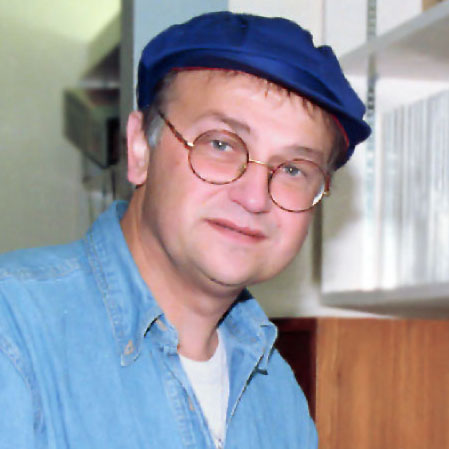Alain Fournier is a Professor in the Department of Computer Science at the University of British Columbia, co-director of Imager, its computer graphics laboratory, and Director of GraFiC, a UBC/IBM Canada partnership dedicated to computer animation. Born in Lyon, France, in 1943 and raised in Bourg-en-Bresse, a mere 60 km, but a world apart from Lyon, he went through the standard French elementary and secondary Lyee schooling. He next studied Chemical Engineering in Lyon, and graduated in 1965 as an engineer. Immediately upon graduation he came to Montreal, for the declared purpose of studying Chemistry at the Université de Montréal. One thing led to another, and he started teaching Chemistry in 1967.
After 8 years of college teaching, he decided to undertake graduate studies in computer science, and entered the Ph.D. program at the University of Texas at Dallas. There he successively realized that there was more to computer science than programming, that this “more” was actually interesting, and that making pictures with computers looked like a potentially enjoyable activity. The latter revelation was mediated by the presence of Henry Fuchs and his frame buffer.
When Henry Fuchs departed for the University of North Carolina, he started his Ph.D. work with Zvi Kedem in computational geometry, but got rapidly side-tracked, and tried with fellow graduate student Don Fussell to reproduce some of Beniot Mendelbrot’s amazing images. They developed their own recursive subdivision method to generate approximations of fractional Brownian motion, together with methods to map the result unto objects modelled as piece-wise parametric surfaces. This became the core of his Ph.D. dissertation completed in 1980.
Upon graduation he returned to Canada, and accepted a position in the Department of Computer Science, University of Toronto. The main attraction, beside the overall distinction of the department, is that there was a well established computer graphics lab. Ron Baecker, covered animation to user interface, and Bill Buxton just finished his pioneering work in computer music, plus many other things. It was thrilling to have the best of both worlds, not only a solidly established environment but also an opportunity to create a modelling/rendering lab. In addition, there was access to some of the best graduate students anywhere. In the 9 years there, he had the chance to supervise four remarkable Ph.D. students, Delfin Montuno, John Amanatides, Eugene Fiume and Avi Naiman, plus 9 Master students.
During this time span, many interesting things happened: the apparition of John Danahy and his vision for landscape architecture, the creation of Alias, the collaboration with the Canadian Broadcasting Corporation through Catherine Richards. At some point in the mid-eighties the Toronto Lab became one of the more prolific producers of SIGGRAPH papers along with Caltech, Cornell and Lucasfilm.
Alain Fournier spent 2 years on leave from Toronto from 1985 to 1987. The main reason was to be with Adrienne Drobnies. The side-effects were to spend a year at Stanford, teaching graduate courses there and at UC Santa Cruz, and another year at Xerox PARC, mainly enjoying the surroundings, writing papers and trying to write a book. During that period he collaborated with Bill Reeves at Lucasfilm on work on the modelling of ocean waves. The most important event of that period is nevertheless the birth of Ariel, his daughter, in March 1987.
Meanwhile back in Toronto, Eugene Fiume had been hired (and Ron Baecker had returned), so that when Fournier went back he found a more active and exciting lab than ever. The collaboration with Eugene Fiume in particular proved to be even more enriching than it had been before. The group grew even larger with the arrival of Marylin Mantei, who helped start the large effort in computer supported cooperative work there. Then something unexpected happened. In the spring of 1989 Adrienne Drobnies had a job offer from Children’s Hospital in Vancouver, and he enquired about the prospects around Vancouver. He had some indications that computer graphics at UBC was one of the areas they wanted to build. Having decided to move (reluctantly leaving Toronto) he found himself in this rare situation where more was delivered than was promised. With the generous support of the department and the University, and with two Ph.D. students making the move with him, there soon was a productive lab (which they called Imager) where there was nothing before in the department. This got even more exciting the following year when Kelly Booth showed an interest in joining him, and making it into one of the biggest and best labs in North America. Largely through the efforts of Maria Klawe, IBM Canada decided to give to UBC nearly $1M worth of graphics workstations, and this plus matching funds from the province of British Columbia created GraFiC (Graphics and Film in Computing), a lab dedicated to the development and use of computer animation for research, education, scientific visualization and communication. GraFiC works in synergy with Imager, and participated in projects resulting in more than 40mm of animation with more than 15 different departments, individual and groups outside of UBC.
His main research interests have included the modelling of natural phenomena, shape modelling in general, in particular with parametric surfaces, and rendering. He has worked on several topics related to filtering, especially space-variant filters and the filtering of bump-maps. Another topic he started recently to investigate is Computer Augmented Reality, whose goal is the merging of real and computer generated images, with emphasis on common illumination.





 Alain Fournier
Alain Fournier